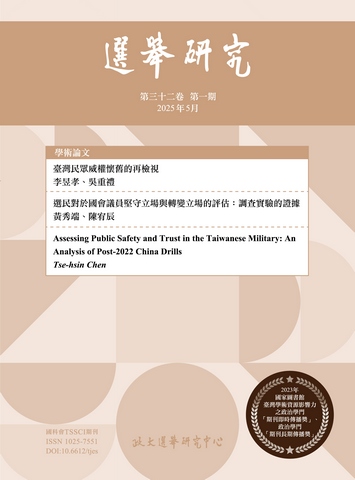 |
 本站僅提供期刊文獻檢索。 本站僅提供期刊文獻檢索。
【月旦知識庫】是否收錄該篇全文,敬請【登入】查詢為準。
 最新【購點活動】 最新【購點活動】
|
| 篇名 |
問卷調查題型設計的效應檢證:以「政治知識」測量的隨機實驗為例
|
| 並列篇名 |
Effects of Survey Questionnaire Design: A Random Experiment in Measuring Political Knowledge as an Example |
| 作者 |
林美榕、莊文忠 (Wen-Jong Juang) |
| 中文摘要 |
問卷調查係為了探詢受訪者對特定議題之意見、態度或行為,不但受訪者本身所擁有的相關訊息多寡可能影響其回答意願,題目與選項的設計型態也會左右受訪者的回答模式。有鑑於實務上大多數的問卷調查常囿於調查成本與問卷長度的考量,無法針對同一概念採取多元的題型設計,以確認受訪者在不同題型設計下的回答模式。因此,本研究乃採取實驗設計方式,以台灣選舉與民主化調查(TEDS)的政治知識測量題組為例,依據:(1)「開放VS.封閉」的題型設計,(2)是否提供「無反應」選項,設計成四種不同版本的問卷題目。以大學生為施測對象,採取「後測控制組設計」(posttest-only control-group design),將不同問卷版本依實驗設計原理,隨機發放給學生填答,共計回收1,110份有效問卷。本研究結果有幾個發現:(1)題型和無反應選項的設計的確會影響到受訪者的回答模式,封閉型的題目設計有助於增加受訪者的答對比例,同樣也會產生高於開放型題目的答錯率;(2)開放型的題目設計,因無選項可供參考,也會降低受訪者的回答意願,因而有較高的無反應比例;(3)藉由題型和無反應選項的組合設計,可以較為精確地估計Mondak(1999)所建構之受訪者類型,但各類型的比例組合會因政治知識測量題目的難易而產生較大的變動。
A survey is designed to explore the participants' opinions, attitudes and actions towards certain topics. The amount of information possessed by participants is not the only factor that influences their willingness to participate; question types and options design also influence participants' responses. In reality, given cost constraints and questionnaire length, it is not feasible to provide a multiple survey design for a single concept, or to verify participants' response mode under different survey designs. This study used an experimental design to measure political knowledge from Taiwan's Election and Democratization Study (TEDS) as an example, based on (1) an “open-ended vs. close-ended” question design; (2) whether it provides “non-response” as an option, to design four different types of surveys. The study uses a posttest-only control group design with university students as participants. We randomly released the questionnaires to participants and had 1,110 valid questionnaires. The study found that question type and non-response design affects the participant response mode; a close-ended questionnaire design does increase the correct response ratio from participants, but it also produces a higher proportion of incorrect answers than an open-ended questionnaire. An openended questionnaire design does not have options as reference, and so it could lower the willingness of participants to take part in the survey, and it therefore resulted in a higher non-response ratio. From the composite design of question type and non-response option, we were able to precisely estimate types of participants as in Mondak (1999), but the combinations of different types of participants vary significantly as results from the level of difficulties in a questionnaire designed to measure political knowledge. |
| 英文摘要 |
A survey is designed to explore the participants' opinions, attitudes and actions towards certain topics. The amount of information possessed by participants is not the only factor that influences their willingness to participate; question types and options design also influence participants' responses. In reality, given cost constraints and questionnaire length, it is not feasible to provide a multiple survey design for a single concept, or to verify participants' response mode under different survey designs. This study used an experimental design to measure political knowledge from Taiwan's Election and Democratization Study (TEDS) as an example, based on (1) an “open-ended vs. close-ended” question design; (2) whether it provides “non-response” as an option, to design four different types of surveys. The study uses a posttest-only control group design with university students as participants. We randomly released the questionnaires to participants and had 1,110 valid questionnaires. The study found that question type and non-response design affects the participant response mode; a close-ended questionnaire design does increase the correct response ratio from participants, but it also produces a higher proportion of incorrect answers than an open-ended questionnaire. An openended questionnaire design does not have options as reference, and so it could lower the willingness of participants to take part in the survey, and it therefore resulted in a higher non-response ratio. From the composite design of question type and non-response option, we were able to precisely estimate types of participants as in Mondak (1999), but the combinations of different types of participants vary significantly as results from the level of difficulties in a questionnaire designed to measure political knowledge. |
| 起訖頁 |
37-73 |
| 關鍵詞 |
政治知識、問卷題目、實驗設計、測量效度、民意調查、political knowledge、survey questionnaire、experiment design、measurement validity、opinion poll |
| 刊名 |
選舉研究 |
| 期數 |
201805 (25:1期) |
| 出版單位 |
政大出版社;國立政治大學選舉研究中心
|
| 該期刊-上一篇 |
選舉制度與憲政體制的制度組合:半總統制民主國家的跨國分析 |
| 該期刊-下一篇 |
台灣民眾的制衡觀與分裂投票:GSEM方法之應用 |
| |
|
新書閱讀
最新影音
優惠活動
|

